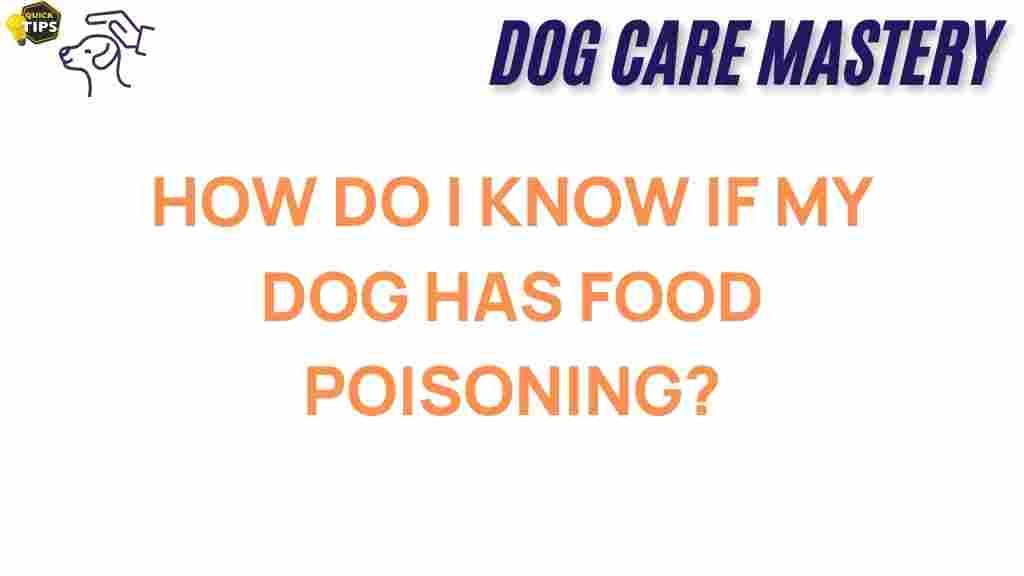Dog Health: Uncovering the Signs of Food Poisoning in Dogs
As a dog owner, ensuring the health and well-being of your furry friend is a top priority. One of the significant concerns for dog health is food poisoning, which can occur when dogs consume contaminated or toxic food. Recognizing the signs of food poisoning early can make a difference in your dog’s recovery. In this article, we will explore how to identify food poisoning in dogs, the symptoms to watch for, and steps to take if you suspect your pet is affected.
Understanding Food Poisoning in Dogs
Food poisoning in dogs can be caused by various factors, including:
- Bacterial contamination (e.g., Salmonella, E. coli)
- Consumption of toxic foods (e.g., chocolate, grapes, onions)
- Expired or spoiled food
- Contaminated water sources
Knowing the potential causes of food poisoning is crucial for preventing it and ensuring your dog’s health. If you suspect your dog has ingested something harmful, it’s essential to act quickly.
Common Symptoms of Food Poisoning in Dogs
Recognizing the signs of food poisoning is vital for prompt treatment. Here are some common symptoms to watch for:
- Vomiting: Frequent vomiting is often one of the first signs of food poisoning.
- Diarrhea: Watery or bloody diarrhea can indicate gastrointestinal distress.
- Lethargy: If your dog seems unusually tired or inactive, it could be a sign of illness.
- Loss of appetite: A sudden disinterest in food can be a red flag.
- Abdominal pain: Dogs may show signs of discomfort by whining or avoiding touch.
- Dehydration: Symptoms include dry gums, excessive thirst, and lethargy.
- Behavioral changes: Look for unusual behavior, such as increased aggression or hiding.
If your dog exhibits any of these symptoms, it’s essential to take action immediately.
Step-by-Step Process for Identifying Food Poisoning in Dogs
Identifying food poisoning in your dog involves careful observation and assessment. Follow these steps to determine if your dog may be suffering from food poisoning:
Step 1: Monitor Your Dog
Keep a close eye on your dog for any signs of distress. Take note of any unusual behaviors or symptoms. If your dog has recently eaten something new or out of the ordinary, make a mental note of it.
Step 2: Check Their Diet
Review what your dog has consumed recently. Consider the following:
- Did they eat any human food that could be toxic?
- Have they eaten expired or spoiled food?
- Did they have access to garbage or other potentially harmful substances?
Identifying the source of the problem can help in assessing the situation.
Step 3: Look for Additional Symptoms
Aside from the common symptoms mentioned earlier, look for any other signs that may indicate a more severe condition:
- Fever: A temperature above 102.5°F may indicate infection.
- Seizures: This can be a sign of severe poisoning or neurological issues.
- Jaundice: Yellowing of the skin or eyes can indicate liver problems.
If you notice any of these severe symptoms, seek veterinary help immediately.
Step 4: Contact Your Veterinarian
If you suspect food poisoning, contact your veterinarian as soon as possible. Provide them with the following information:
- Your dog’s age, weight, and breed
- A detailed account of symptoms and duration
- A list of foods your dog has consumed recently
- Any medications your dog is currently taking
Your veterinarian may recommend bringing your dog in for an examination or provide guidance over the phone.
Step 5: Follow Veterinary Advice
After consulting with your veterinarian, follow their recommendations closely. This may include:
- Withholding food for a specific period
- Providing a bland diet once they can eat again
- Administering prescribed medications
- Monitoring for any worsening symptoms
Adhering to your veterinarian’s advice is crucial for your dog’s recovery.
Troubleshooting Tips for Dog Health
Preventing food poisoning is just as important as recognizing its signs. Here are some tips to maintain your dog’s health:
- Feed a balanced diet: Ensure your dog is eating high-quality dog food that meets their nutritional needs.
- Avoid human food: Many human foods can be toxic to dogs. Stick to dog-safe treats.
- Store food properly: Keep dog food sealed and stored in a cool, dry place to prevent spoilage.
- Regular vet check-ups: Regular visits to the veterinarian can help catch potential health issues early.
- Educate yourself: Stay informed about foods that are harmful to dogs. Resources like the ASPCA provide valuable information.
By taking preventive measures, you can help keep your dog healthy and reduce the risk of food poisoning.
Conclusion
Recognizing the signs of food poisoning in dogs is essential for their health and well-being. By monitoring your dog’s behavior, understanding potential causes, and taking prompt action, you can help ensure a swift recovery. Always consult with your veterinarian if you suspect food poisoning or notice any concerning symptoms. Remember, maintaining your dog’s health goes beyond just recognizing illness; it includes preventive care and education. For more information on maintaining dog health, check out our other articles here.
This article is in the category Health and created by dogcaremastery Team
